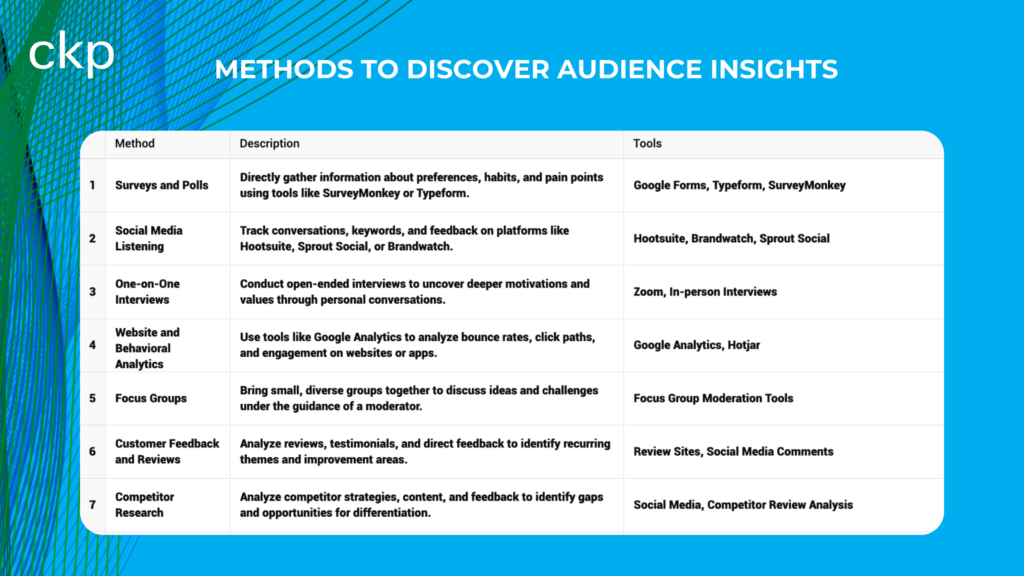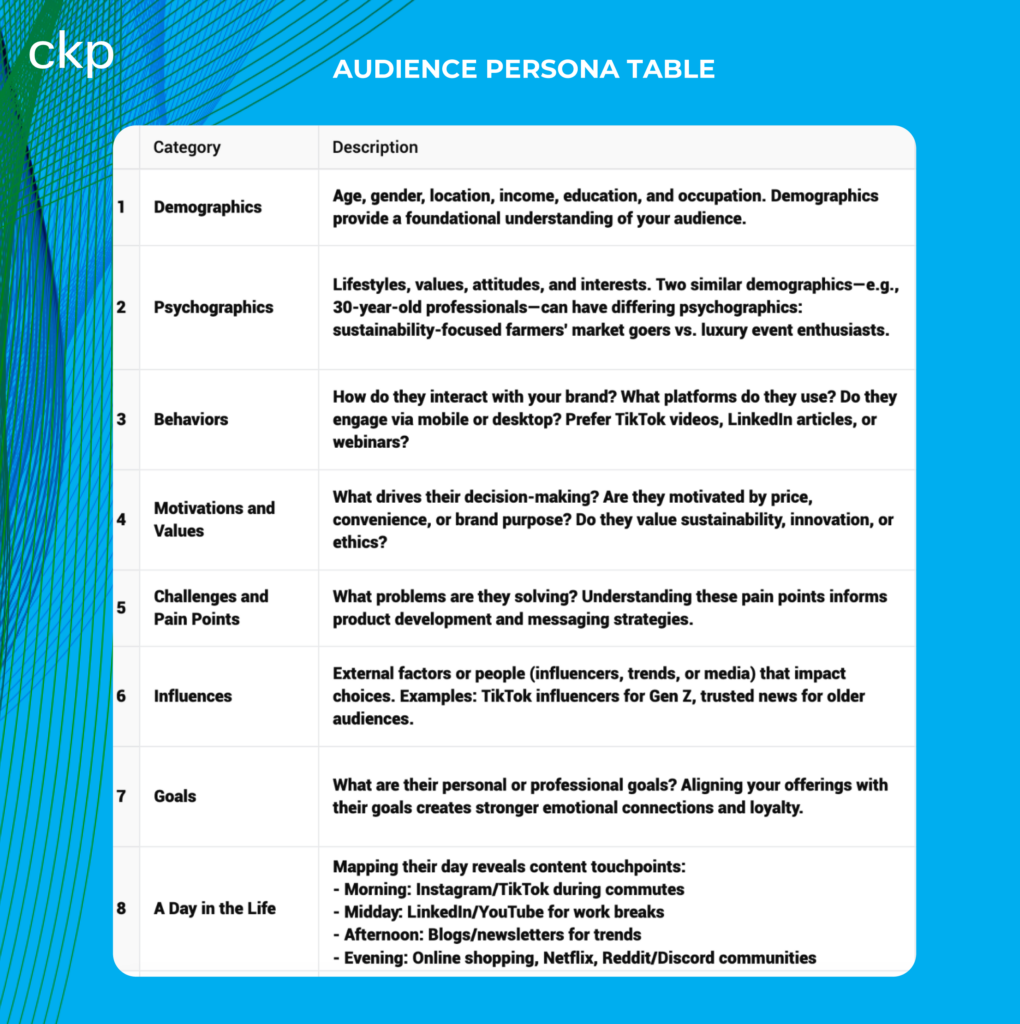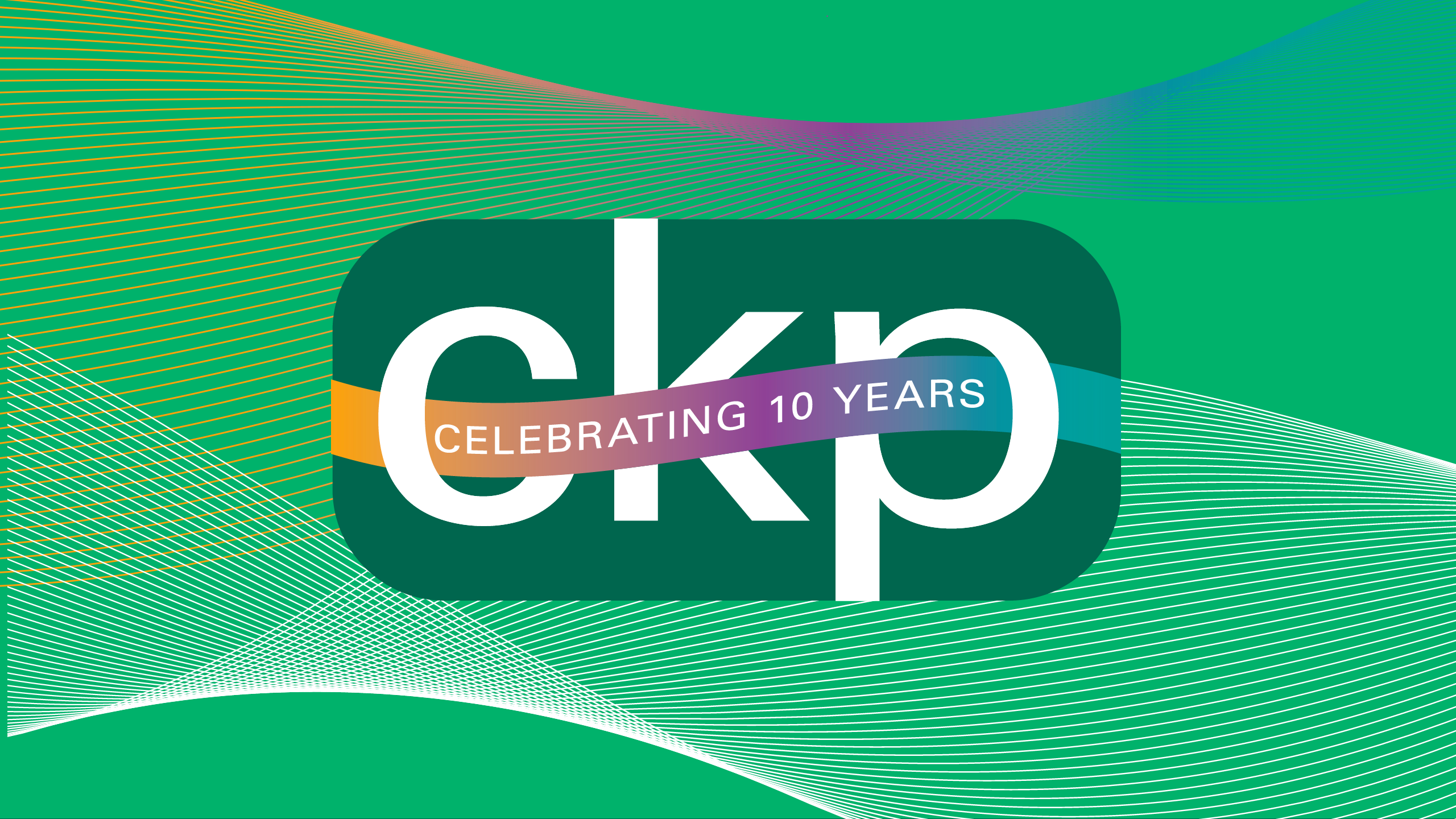Beyond Demographics: Understanding What Your Audience Really Wants—And How to Turn Insights Into Advocacy Action

During my initial conversations with new clients, I always start with the same question: “What audiences are important to you?” The answers usually include basic demographics—age range, location, industry—and sometimes a bit of cultural context. At first glance, this top-level information can feel like a dating profile on Hinge: superficial and lacking depth. While it might be enough to catch some initial attention and swap right, it rarely provides the substance required to forge truly meaningful connections.
Think about it this way: if you show up to a party and try to talk to someone without knowing anything about them, the conversation quickly becomes awkward and unproductive. That’s precisely what it’s like to engage an audience when all you have is surface-level data. Yes, demographic details can matter, but they only scratch the surface of what really motivates people to take action or become brand advocates.
This question—What audiences are important to you?—is foundational. It helps us see not only whom our clients are targeting but also how they currently think about their audiences. Yet superficial answers inevitably hinder our ability to connect on a deeper level. In other words, that basic demographic snapshot might get you a “first date” with your audience, but it won’t secure the second or third. Nor will it help build the trust needed to turn casual followers into raving fans.
A brand or organization needs more than just superficial information to truly resonate. If all you know is age, location, and occupation, you’re missing out on the emotional and practical drivers behind your audience’s decisions. Are they motivated by sustainability? Are they struggling with a specific pain point your product can solve? These are the questions that help you go beyond superficial targeting and into genuine engagement.
Advocacy is fueled by a brand’s ability to demonstrate it truly “gets” its audience. That means understanding values, motivations, and how your product or service can add meaning to their lives. For instance, if your core demographic values sustainability over convenience, marketing a product as premium just based on its higher price point could flop. You might look great on paper, but you’ll miss what actually resonates with the people you want to reach.
Without deeper insights, even a well-crafted strategy can fall flat. You might invest heavily in branding or promotional efforts that mean little to an audience seeking something entirely different. The brand story that truly inspires them—the one that turns them into lifelong advocates—comes from understanding their core beliefs and aspirations.
If the first step is identifying who your audience is, the second—and most important—step is discovering why they care. Digging into motivations, pain points, and values unlocks the potential to make your audience feel genuinely seen and understood.
In this blog, we’ll explore methods to uncover deeper audience insights—everything from qualitative research to social listening and data analytics. We’ll cover:
- Why Audience Insights Matter
- Methods to Discover What Makes Audience Tick
- Building Audience Personas
- Turning Insights Into Advocacy
- How Do You Know It’s Time to Go Deeper?
Why Audience Insights Matter
According to a 2023 report by McKinsey & Company, businesses that conduct robust target audience analysis see a 60% higher conversion rate and significantly improved customer engagement. For example, brands that use detailed segmentation tools often report faster sales cycles and better ROI.
A recent Edelman Trust Barometer study shows that 75% of consumers are more likely to advocate for brands that demonstrate a thorough understanding of their needs and values. Audience insights can also save your organization up to 40% on marketing expenses by shining a light on what truly resonates. For instance, one CKP client hosting an annual lifestyle festival adopted motivational segmentation to target attendee interests, resulting in higher engagement, bigger crowds, and better resource allocation. The outcome? A more strategic—and more cost-effective—approach to marketing.
A report by ABC Marketing finds that 68% of customers who feel understood by a brand are more likely to recommend it. Building this sense of understanding isn’t just about meeting immediate needs. It’s about nurturing the long-term loyalty and trust that transform customers into powerful advocates for your brand.
Methods to Discover What Makes Audience Tick
How do you get started? There’s no need to reinvent the wheel. Proven methods already exist to help you dig deeper and truly understand what motivates your audience.
- Surveys and Polls: Surveys are a direct way to gather information about your audience. They allow you to ask specific questions about their preferences, habits, and pain points. Tools like Google Forms, SurveyMonkey, and Typeform make it easy to design and distribute surveys. Keep surveys concise and to the point. Ask both closed (yes/no, multiple choice) and open-ended questions to capture a mix of qualitative and quantitative insights.
- Social Media Listening: Your audience is already talking—you just have to listen. Social media platforms offer a wealth of information on what your audience cares about, their challenges, and how they interact with competitors or other brands. Use tools like Hootsuite, Brandwatch, or Sprout Social to track keywords, hashtags, and mentions. Look for patterns in their conversations and feedback.
- One-on-One Interviews: Nothing beats a conversation. One-on-one interviews allow you to go beyond surface-level information and uncover deeper motivations and values. Focus on open-ended questions. Ask about their experiences, what they value, and why they engage with certain brands.
- Website and Behavioral Analytics: Analytics tools like Google Analytics help you understand how your audience interacts with your website or app. Look at bounce rates, time spent on pages, and click paths. Identify where they lose interest and where they engage the most.
- Focus Groups: Focus groups bring together small groups of your audience to discuss ideas, challenges, and reactions to your brand or product. Ensure the group is diverse enough to represent different segments of your audience. A skilled moderator can guide the discussion to uncover valuable insights.
- Customer Feedback and Reviews: Reviews, testimonials, and direct feedback can reveal what your audience loves and what needs improvement. Comb through review sites, social media comments, and feedback emails. Analyze recurring themes to identify key trends.
- Competitor Research: Looking at your competitors can provide valuable insights into what audiences expect from brands like yours. Analyze their social media, customer reviews, and content strategy. Identify what they’re doing well and where you can differentiate.

Building Audience Personas
Once you’ve gathered insights, the next step is to translate that data into actionable audience personas. These personas are fictional but research-based profiles that represent segments of your audience. Done well, they help you personalize your approach, prioritize messaging, and tailor strategies that resonate.
What Is an Audience Persona? An audience persona is a detailed profile that includes demographics, psychographics, behaviors, motivations, and pain points. Think of it as the most important “cheat sheet” for your audience—who they are, what they care about, and how you can connect with them. Psychographics go beyond basic demographics to explore the values, attitudes, lifestyles, and interests that influence your audience’s decisions. While demographics tell you who your audience is, psychographics explain why they behave the way they do.
For example:
- Lifestyle: Do they prioritize sustainability? Are they fitness enthusiasts?
- Values: What do they care most about—authenticity, convenience, or affordability?
- Interests: Are they drawn to technology, arts, or community events?
When it comes to audience personas, there’s no universal template that works for everyone and every situation. The key is to focus on what’s important to you and your brand. Think about the insights that matter most for your audience and your goals—whether that’s lifestyle, motivations, behaviors, or pain points—and build a template that’s exclusive to your needs.
Here are things to consider including in your persona:
- Demographics: Age, gender, location, income, education, and occupation. Demographics provide a foundational understanding of your audience.
- Psychographics: Lifestyles, values, attitudes, and interests. For example, two audience segments may share the same demographic—say, 30-year-old professionals living in urban areas—but psychographics reveal their differences. One group might prioritize sustainability and spend their weekends at farmers’ markets, while the other values luxury experiences and regularly attends high-end events.
- Behaviors: How do they interact with your brand? What platforms do they use? Are they primarily engaging with your content through mobile devices or desktops? Do they prefer short-form videos on TikTok, long-form articles on LinkedIn, or interactive experiences like webinars?
- Motivations and Values: What drives their decision-making? What do they care most about? Are they motivated by price, convenience, or brand purpose? Do they value sustainability, innovation, or community involvement? Some audiences may prioritize affordability over premium features, while others may align strongly with brands that champion ethical practices.
- Challenges and Pain Points: What problems are they trying to solve? Identifying these pain points not only helps you empathize with your audience but also informs your product development and messaging strategies.
- Influences: What external factors or people (influencers, trends, or media) impact their choices and behaviors? Influences can include digital influencers they trust, emerging trends shaping their industry or lifestyle, and media sources they regularly consume. For example, Gen Z audiences may be heavily influenced by social media personalities on TikTok or Instagram, while older audiences might rely more on trusted news outlets, niche publications, or recommendations from thought leaders.
- Goals: What are they trying to achieve in their personal or professional life? Aligning your brand’s message, product, or service with your audience’s goals can create stronger emotional connections and lasting brand loyalty.
- A Day in the Life: Imagine a typical day for your audience. This stortytelling approach allows you to identify the key touchpoints where your brand can deliver value. From creating snackable morning content to positioning yourself as a trusted resource for evening purchases, these insights allow you to align your strategy with how your audience behaves throughout their day. Let’s say your audience consists of young professionals in their late 20s.
- In the Morning: They scroll through Instagram or TikTok during their commute, engaging with quick, visually appealing content like videos and reels.
- Midday: At work, they browse LinkedIn for professional updates or use YouTube to catch up on educational content during their lunch break.
- Afternoon: As the workday winds down, they check their favorite blogs or newsletters for trending stories or product recommendations.
- Evening: Relaxing at home, they might shop online, stream content on platforms like Netflix, or engage with niche communities on Reddit or Discord.

Turning Insights Into Advocacy
So, you’ve done the work: You know your audience inside and out. But now comes the critical question: How do you take all this information and use it to create meaningful connections that turn your audience into loyal advocates? Here are four steps to transform what you know about your audience into strategies that build trust, foster engagement, and inspire advocacy.
Personalize Your Messaging
Your audience wants to feel seen, heard, and understood. Use the insights you’ve gathered to create messaging that resonates on a personal level.
- Speak to Their Values: Tailor your communication to align with what matters most to your audience.
- Be Human: Avoid generic or robotic messaging. Use language that reflects an understanding of your audience’s tone, preferences, and culture.
- Example: A fitness brand might send a personalized email campaign to users who want to “stay active but save time.” The messaging could highlight quick, effective workouts tailored to their busy schedules—showing the brand understands their pain points and offers a solution.
Meet Them Where They Are
Knowing where and when your audience engages with content is just as important as what you say. Use behavioral insights to show up in the right places at the right times.
- Identify Key Platforms: Does your audience prefer TikTok, Instagram, LinkedIn, or newsletters? Create content that fits seamlessly into their preferred channels.
- Timing Matters: Behavioral data can help you understand when your audience is most active. Morning commutes? Afternoon breaks? Evenings on the couch? Deliver content during those moments.
- Example: If data shows your audience scrolls TikTok in the morning, create short, energetic videos that offer bite-sized value—like a quick tip, hack, or motivational message—to start their day.
Solve Real Problems
Audiences connect with brands that add value to their lives. Use your insights to identify their challenges and position your product or service as a solution.
- Address Pain Points: Whether your audience struggles with time management, finding affordable options, or achieving personal goals, align your offerings to meet those needs.
- Show Tangible Benefits: Don’t just say you can help—prove it with case studies, examples, or clear outcomes.
- Example: A meal delivery service targeting busy professionals could emphasize “saving two hours a week” with pre-prepped, healthy meals. This directly addresses the audience’s challenge of juggling work and health.
Create Shared Experiences
Advocacy is born out of trust and emotional connection. To build that, create opportunities for your audience to engage with your brand and with each other.
- Host Events or Webinars: Provide opportunities for your audience to connect, learn, and share experiences.
- Build Communities: Foster spaces where your audience can interact—online groups, forums, or exclusive memberships.
- Encourage Participation: Invite your audience to share their stories, feedback, or content (user-generated content).
- Example: A lifestyle brand might host a live Q&A webinar featuring experts who align with audience values (like sustainability or wellness). This shared experience not only educates but also strengthens emotional bonds with the brand.
How Do You Know It’s Time to Go Deeper?
At the end of the day, your audience isn’t a spreadsheet or a series of neatly labeled classifications—they’re real people. The more your insights jump off the page and give your target audiences life, the more opportunities you’ll see to connect with them in meaningful, human ways.
Think of personas not as static one-pagers, but as living, breathing reflections of the people you want to reach. Their stories, struggles, and aspirations are where your brand has the chance to make an impact. When you approach your audience with empathy and curiosity, you’re not just marketing—you’re building relationships that inspire trust, loyalty, and advocacy.
Because people don’t connect with personas—they connect with brands that get them.
If your marketing feels generic, engagement is lagging, or you’re getting great metrics but not meaningful results, it might be time to revisit your audience insights. Are you relying too heavily on broad demographics without understanding motivations? Do your campaigns reflect who your audience is but miss the mark on why they care? If your personas feel flat or your strategy isn’t sparking action, it’s a sign you need to dig deeper.
Real connections happen when your audience sees themselves in your brand. If you’re not quite there, it’s time to breathe life into your insights and turn data into understanding.
More Blog Posts

Let’s be real—communication at work is kind of like a group chat. Some people over-share, some barely respond, and others...

Once upon a time, PR meant faxing a press release and hoping someone, somewhere, had paper in their machine. All...

Employee Appreciation Day, recognized on the first Friday in March, will be celebrated this year on March 7. It is...

1. The Power of Sustained Impression (Or: Stop Passing Out at First Dates) Let me tell you about a date...

